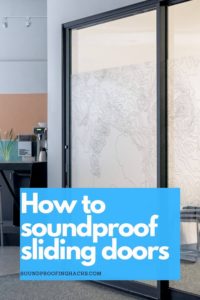Best ways to soundproof sliding doors
Do you have a sliding glass door leading outside or a sliding wooden door inside?
Then chances are you have some level of unwanted noise coming in from the other side.

The noise of your laundry room might be disturbing your meals in the nearby kitchen. You might have new neighbors or children outside your home.
If you encountered any situations like this, then chances are you would want to cut down on these distracting noise.
Luckily, there are a few simple things you can do to help cut down on noise and get the focus and quiet you want.
The are several fairly easy strategies that you can try to help cut down on unwanted sound: weather stripping, door sweeps, curtains, sound blankets and similar items.
Below I go through the strategies in detail and recommend some of the highest-rated products on Amazon.
Ready to soundproof your sliding doors?
I am an Amazon Affiliate, which means I may make a commission if you purchase something through the links here. There is NO extra cost to you at all, and THANK YOU so much for the support.
Related: Does soundproof paint work?
Contents: Skip to section
Who can benefit from this article?

You don’t need to be a specialist or a handyman.
If you have sliding doors and too much noise, this article is for you.
The strategies discussed below only require a few items and a few common household tools.
The installation does not require too much time and you can start with the basics and add more as needed.
What are the best strategies and do they really work?
We’re discussing two types of doors here: internal sliding doors and exterior (likely glass) sliding doors. There are some differences and some overlap.
We’ll discuss both.
For indoor sliding doors
The type of door being discussed here is the popular sliding barn door. These are often used with laundry rooms, closets and even bathrooms. Note: if you’re trying to silence a sliding pocket door, some these strategies will work too, such as the blanket and stripping, so you will find something useful regardless. Below I will give a brief overview of the strategies and then over the materials you will need.
Hey, quick one. If you intend to start a soundproofing project soon, check out our Best Materials for Soundproofing post to get a headstart. Most projects require similar materials, so this post will save you a ton of time researching.
Strategy 1: Weather Stripping
There are several types of weather stripping available and you would want to choose the one that best first your specific needs and dimensions.
Weather stripping is commonly designed to cut down on drafts and changes in temperature. However, it also goes a long way towards sealing any openings that might otherwise leak sound from the other side of the door.
You can use this strategy for indoor sliding doors and exterior sliding glass doors.
Strategy 2: Door Draft Stoppers
These draft stoppers attach to the bottom of an interior door. Most indoor sliding doors have a gap between the bottom of the door and floor, which obviously allows lots of sound pollution.
There are two primary types of draft stoppers to consider.
The first is a rubber edge that comes straight down from the door to the floor to create a seal. It is light weight and often comes with its own self-adhesive. However, if the stopper doesn’t touch the floor there is room for sound to leak, and if it does touch the floor, it may create a slight drag when you open and close the door. So, there are tradeoffs.
The second are commonly called door sweeps and are soft silicone brushes that reach the floor from the bottom of the door.
The brush types are probably better for a project like this – they won’t do any damage to the floor and will allow an easy slide while still blocking out noise.
These tend to be just a little heavier and may require screws (often included).
Strategy 3: Foam Pads
These foam pads can be cut and attached to the edges of the door that faces the wall. They are soft and will allow for the door to slide open and shut with minimal wall-friction.
The benefit is that when the door is closed, the pads will fill that air gap between the door and wall that would otherwise leak noise. These can be attached to the door with adhesive.
What items should I use to achieve these strategies for interior doors?
Magzo Foam Tape Weather Strip
- This foam weather stripping tape can be used as insulation and sound absorbing materials, and are widely used in door seals
- Soft no harmful adhesive foam strips with great flame retardant, does not pollute equipment, oil resistance, resistant to corrosion, dust proof, anti-skidding and insulating
- Easy to handle and install: clean the surface, measure, cut, and peel off the backing film. Apply the seal tape as needed
Keeping Fun Indoor Weather Stripping
- Comes in two sizes with its own adhesive backing
- Very flexible and easy to install
- Acts as thermal insulation and soundproofing weather strip
Self Adhesive Seal Strip Weather Strip
- Comes in two sizes with its own adhesive backing
- Very flexible and easy to install
- Acts as thermal insulation and soundproofing weather strip
Door Bottom Door Sweep
- These attach to the bottom of the door by adhesive or screws and resemble little brooms (hence their name).
- They cut down on the sound and allow for ease of door sliding.
Door Draft Stopper
- These are similar to the sweep but are wedges that come directly down to the floor.
- They will provide better sound protection, but might slow or interfere slightly with the door sliding.
Weighted Under-door Draft Stopper
- This requires no installation; you just drop into place and push up against the door.
- Resembles a snake and sits up against the floor gap, blocking out sound.
- Needs to be pushed back into place each time you open and close the door, but is a quick-fix if you’re not sure that you want to try and of the more complex options.
Acoustic Foam Blocks
- Require a bit more work but can have the greatest impact.
- Measure, cut, and attach behind the door on the side that faces the wall.
- They fill the air gap between the wall and door and cut back on sound transference.
- Can be attached with an adhesive.
For outdoor sliding doors
These doors require slightly different strategies than the interior doors, but you still have multiple options here.
Strategy 1: Soundproof curtains
The best option for cutting back on sound are soundproof curtains. There are lot of styles and thicknesses to choose from.
However, most of these offer a combination of blackout curtains to cut back on light as well as sound insulations.
When you have these closed, you lose the view of the door, but they will cut back on sound quite a bit.
Strategy 2: Weather Stripping
These products are the same discussed above. There are multiple types to choose from. The ones mentioned above are self-adhesive and easy to install. They offer both thermal protection as well as sound insulation.
Strategy 3: Blankets
The blanket discussed below with the other materials includes gromets to make it easy to attach.
While you lose your view completely, they are very easy to install and are easier to remove than curtains.
What materials are available for this project?
Nicetown Soundproof Curtains
- Each Classic Lined Patio Door Curtain measures 100″ wide x 84″ long.
- Sewn in black liner backing makes the drapes thick enough to completely keep out sunlight
- Soundproofing: Heavyweight Blackout Lined Curtain Panels absorb sound twice as much as ordinary 1-layer of curtains
- Easy to care for: sturdy design and machine washable with mild detergent
Rose Home Fashion Thermal Blackout Curtain
- Ready To Hang; 100″ wide x 84″ length
- Thermal insulation keeps out the heat and cold out
- Blackout curtains cut down on light and sound pollution, keeping the room cool and quiet
- Easy to Machine Wash and Dry.
Gromet Blanket
- Reinforced metal grommets make this easier to hang than some other insulating blankets
- Dampens noise and vibration
- Easy to add and remove
- Can be hung from hooks or other implements
Patio Pacific Sliding Glass Door Draft Stopper
- Sliding door draft stopper fits all patio panel installations
- Draft sealer for sliding glass doors and windows blocks wind draft and cold air and also insulates against sound pollution
- Adheres to the sliding door for a secure fit
- Available in black or white
Frequently Asked Questions (FAQ)
Does this actually work? Can you actually soundproof sliding doors?
Sliding doors obviously will not achieve the soundproof level that a traditional, heavy door will have.
However, you can improve the sound dampening quite a bit by addressing any air gaps with stripping and other materials.
If the sound is extreme, regardless of it being an interior door or an exterior door, insulating curtains or blankets will likely be necessary to achieve what you need.
Is it difficult to soundproof sliding doors?
The materials described here are all readily available and easy to install. Most of them come with their own adhesive or methods of attachment.
As long as you’re comfortable installing weather stripping or adhering pads to your door, you will be fine.
Can I just put down a towel to close the gap on the floor?
A towel can help, but it’s not designed to block out sound and will need to be moved every time you want to open and close the door.
Should I just replace my door?
It really depends on you, your door, and the level of sound!
The cost and effort of replacing a door are both higher than adding a few items to the door to cut back on sound.
It is likely worth it to try a few of theses strategies before you go and replace your door.
How to soundproof sliding doors: Conclusion
So, there you have it, a few simple strategies and the required materials to silence your sliding door.
Click the Amazon links above to learn more about the materials and have them delivered to your door!











